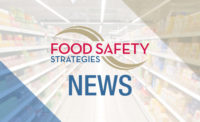Traceability and Food Safety in Produce

According to data from the U.S. Centers for Disease Control and Prevention, approximately 48 million people get sick each year from a foodborne illness, while another 128,000 are hospitalized. Most of the contamination, based on U.S. Food & Drug Administration (FDA) data between 1996 and 2010, likely occurred during the growing, harvesting, manufacturing, packing, holding or transportation process.
Because of the public health burden associated with these preventable outbreaks, great strides have been taken to ensure the safety of produce items in today’s food supply. While outbreaks still occur, traceability measures have been established to protect the food safety system.These include emerging technologies and standards in traceability, such as Global Trade Item Numbers and new software that promotes food safety through sustainability and traceability.
When the Food Safety Modernization Act (FSMA) was signed into law in 2011, the goal was to strengthen the U.S. food safety system. FSMA put the power into the hands of each grower to ensure their food supply was safe and traceable if an outbreak should occur. It’s important to note that there is a difference in traceability between fresh and processed fruits and vegetables, which makes the tracking of fresh produce even more important. While the produce rule does not have specific traceability standards, the enhanced tracking and tracing of food and recordkeeping has two major requirements.
First, FDA, working with the U.S. Department of Agriculture (USDA) and state agencies, must establish pilot projects in coordination with the food industry to explore and evaluate methods and appropriate technologies for rapid and effective tracking and tracing of foods. Second, FDA must publish a notice of proposed rulemaking to establish recordkeeping requirements for high risk foods to help in tracing products.
Typically, when a consumer or food service outlet buys a fresh product, they may not know where it comes from; however, a canned item will have a label with an identifying product code. While fresh produce has historically been much harder to track, the industry has proven that it can be accomplishedwith the right resources in place.
For example, through the Produce Traceability Initiative (PTI), supply chain partners can help enhance a standardized industry approach to future traceability measures. The initiative is a voluntary, industry-wide effort governed by a 34-member leadership council. Members of the initiative cover every aspect of the produce supply chain, which includes growing, storing, cooling, packing, processing and distributing operations. This is done through volunteer working groups that focus on:
• Implementation and promotion of the industry-wide adoption of GS1 standards at the foundation of the PTI, including developing best practices, identifying solutions to implementation issues, and tracking industry implementation.
• Master data issues regarding identifying product attributes, and communicating that data between trading partners.
• Industry communications to ensure two-way discussions between the initiative and industry.
• Technology forums for tech providers to collaborate to support the initiative.
Additionally, it is administered by the Canadian Produce Marketing Association, GSI US, Produce Marketing Association and the United Fresh Produce Association.
The PTI’s goal is to develop a systematic approach to help narrow the impact of potential produce recalls, foodborne illness outbreaks or other problems. However, smaller operations may have problems aligning their traceability systems with PTI, due to the complexity of the system and costs that are associated with the corresponding requirements.
To help along their initiative, the PTI has launched its 7 Milestones to PTI Implementation for case-level electronic traceability in produce. They also have launched a checklist for both growers/packers/shippers and for receivers and buyers.
To date, the industry handles more than 6 billion cases of produce each year, which makes issues such as commingling and repacking even more prevalent.
Commingling occurs when produce from separate suppliers gets mixed together and then distributed in one package to a food service establishment.This can happen on purpose, in the case of finished products that consist of mixed items, or accidentally, in the case of repacking or reworking a productin an inappropriate manner. Commingling can cause issues with traceability if a foodborne illness outbreak occurs or a recall is necessary for certain products. Products have the potential to become contaminated by coming into contact with already contaminated goods. Therefore, it’s important to be able to track each batch of produce included in the repack.
To help the supply chain establish safe commingling practices, suppliers should be able to provide batch or lot numbers for each produce item included in the repack. Additionally, a new batch number should be assigned for the repackaged bundle. The repack facility also must be required to maintain the correct documentation to link each batch back to its respective source. In the event of a recall, each lot of produce must be traced back to its original source and further analysis may be required to determine the original point of contamination.
Whether the packer determines the lot by date, grower, field, buyer or some other identification, a sanitation clean break is required between each lot to ensure the proper segregation of produce items. A clean break, which is a cleaning and sanitation process, must be completed for all food contact surfaces before production begins. It includes the execution of specific Sanitation Standard Operating Procedures followed by a pre-operational assessment to ensure that acceptable results are obtained through visual inspections and ATP testing in some cases. These surfaces include the food contact surfaces of equipment and tools used during production.
Clean breaks are important because these clearly separate a production lot from another. A lack of a “clean break,” along with other poor traceability practices, could result in recalls that have covered a whole production season due to ambiguous or incomplete lot code information. One such example is the 2012 Listeria monocytogenes melon recall from Burch Equipment LLC in 2012. The recall initially included 13,888 cases of whole cantaloupes and 581 bins (110 cantaloupes per bin) of whole cantaloupes. However, it was quickly expanded to the entire growing season’s cantaloupes and honeydew melons.
Clean breaks limit the scope of potential food safety events, establish safe cleaning and sanitation procedures for packing and repacking facilities and provide a necessary check and balance system if a recall should happen.
Overall, produce items should be traced and foodservice operators should make sure the produce they are using can be easily linked back to its source. Here are a few steps to help facilitate produce traceability:
1. Establish lots at the field level.
2. Segregate products in different lines or production shifts at the facility level.
3. Maintain finished product lot coding information throughout the distribution chain.
By following these steps, traceability can be established and the food safety of produce can be better assured.
Javier Martinez, M.Sc., is the food safety manager at Fresh Concepts.
Looking for a reprint of this article?
From high-res PDFs to custom plaques, order your copy today!





